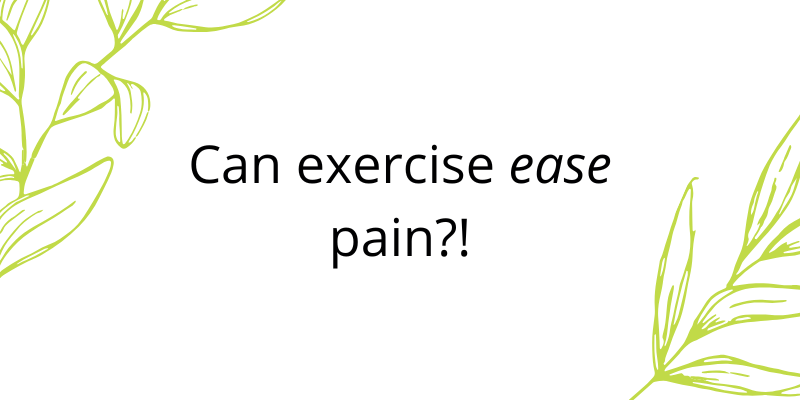Relief in Motion – How Exercise Can Help Ease Pain
When most people think of pain relief, they imagine medication, rest or medical treatments. However, one of the most effective, yet often overlooked, methods to manage and ease pain is regular exercise. It is probably the last thing you think of doing when you are hurting, but research consistently shows that physical activity can help to reduce discomfort, improve function and enhance quality of life.
So, how exactly does exercise help to ease pain? The answer lies in the powerful ways that movement affects the body and mind. From releasing natural painkillers to reducing inflammation and improving mood, exercise can be a game-changer for those living with chronic pain or recovering from injury.
7 reasons why exercise can help you to lead a pain free life:
- The body’s natural painkillers – endorphins
Would you rather try a natural painkiller? One of the immediate benefits of exercise is the release of endorphins which are chemicals produced by the body that act as natural painkillers. Endorphins interact with the receptors in your brain to reduce the perception of pain (similar to how pain relief works) but without the risk of addiction or side effects. Activities like running, swimming, cycling, strength training or even a brisk walk can trigger this release. This natural boost not only helps to relieve pain but also improves mood, making exercise a powerful tool if you are dealing with depression or anxiety.
- Reducing inflammation
Do you suffer with arthritis? Chronic inflammation is often a common underlying factor in many painful conditions such as arthritis, fibromyalgia and back pain. Regular exercise has been shown to lower inflammation by reducing the production of pro-inflammatory markers in the body. Low impact exercises such as swimming, walking or yoga can help to decrease inflammation without putting additional strain on your joints. Over time, reducing inflammation can lead to a significant decrease in pain levels and improve overall well-being.
- Strengthening muscles and supporting joints
Would you like to be stronger? Weak muscles can worsen pain by increasing stress on joints and bones. When your muscles are strong, they provide a great support to your body, reducing the load on sensitive areas and enhancing stability. Strength training exercises help to build muscle mass and improve posture, which can be particularly beneficial if you are suffering from back or joint pain. For example, if you have knee pain, you can benefit from strengthening the muscles around the knee and hip, which helps to alleviate pressure on the joint and reduce discomfort during daily activities.
- Improving flexibility and range of motion
Would you like to be more flexible? Tight muscles and limited flexibility can lead to increased pain and a higher risk of injury. Stretching exercises and classes such as yoga or Pilates can improve flexibility, lengthen muscles, and enhance range of motion. This helps to relive muscle tension and promotes better posture, which can reduce discomfort, especially if you have neck, shoulder or back pain due to poor posture or sedentary lifestyles.
- Improving quality of sleep
How well do you sleep? Chronic pain can often disrupt sleep, leading to a vicious cycle where poor sleep increases sensitivity to pain, and increased pain makes it harder to sleep. Regular physical exercise has been proven to improve quality of sleep by helping the body to fall asleep faster and promoting deeper, more restorative sleep. This can help to break the cycle of pain and fatigue, leading to better pain management over time.
- Psychological benefits of exercise
Do you feel emotionally exhausted? Living with any type of constant pain can be emotionally exhausting and can often lead to depression, anxiety and feelings of isolation. Exercise provides psychological relief by boosting mood, improving self-esteem and reducing stress levels. Group exercises can also offer a sense of community and support which can be incredibly beneficial for mental well-being. Come and join in one of our many classes to get a great workout with a good few laughs along the way 😊
- Promoting mobility and independence
Do you want to remain mobile well into old age? Does pain limit your movements? Are you worried about making it worse? These feelings can actually lead to you experiencing greater stiffness, muscle weakness and a loss of mobility over time. Engaging in regular, gentle exercise helps to maintain mobility and independence, allowing you to carry out daily tasks more easily and with less discomfort. Our 30-minute circuit is suitable for any fitness level whether you are wanting to simply improve your mobility or you’re training for an event.
Before beginning any exercise routine, especially if you have chronic pain or an injury, please speak to your doctor or healthcare professional. They will be able to recommend a safe and effective exercise plan based on your specific needs and limitations.
Start slowly and focus on consistency rather than intensity. Doing a little exercise regularly is much better than going all out once a week. Swimming, yoga, Pilates or a stretch class can be a great starting point if you are new to exercise or if you are dealing with a chronic illness. Find something that you enjoy doing. If you want to meet people while you work out, try one of our classes or members can pop along to our coffee morning (10.30am on Tuesdays) for a chat and a laugh :)
Exercise is more than just a way to stay fit. While rest and medication have their place, exercise is a powerful tool for pain relief. By releasing endorphins, reducing inflammation, strengthening muscles and improving mental health, physical activity offers a natural and effective way to reduce pain. While it might be challenging to get moving when you’re in discomfort, starting small and staying consistent can lead to long-term improvements that enhance both physical and emotional well-being.
Much Love
Caroline & Hannah xx
